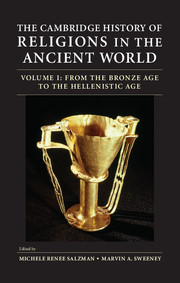Book contents
- Frontmatter
- Contents
- List of Figures and Maps
- List of Contributors
- List of Abbreviations
- Acknowledgments
- Introduction to Volumes I and II
- Introduction to Volume I
- Part I Mesopotamia and the Near East
- 1 Sumerian Religion
- 2 Assyrian and Babylonian Religions
- 3 Hittite Religion
- 4 Zoroastrianism
- 5 Syro-Canaanite Religions
- 6 Israelite and Judean Religions
- Part II Egypt and North Africa
- Part III Greece and the Eastern Mediterranean
- Part IV The Western Mediterranean and Europe
- Suggestions for Further Reading
- General Index
- Index of Citations
- Frontmatter
- Contents
- List of Figures and Maps
- List of Contributors
- List of Abbreviations
- Introduction to Volume II
- Part I Iran and the Near East
- Part II Egypt and North Africa
- Part III Greece and Asia Minor
- Part IV Italy, Roman Gaul, and Spain
- Suggestions for Further Reading
- General Index
- Index of Citations
- References
2 - Assyrian and Babylonian Religions
from Part I - Mesopotamia and the Near East
Published online by Cambridge University Press: 05 October 2013
- Frontmatter
- Contents
- List of Figures and Maps
- List of Contributors
- List of Abbreviations
- Acknowledgments
- Introduction to Volumes I and II
- Introduction to Volume I
- Part I Mesopotamia and the Near East
- 1 Sumerian Religion
- 2 Assyrian and Babylonian Religions
- 3 Hittite Religion
- 4 Zoroastrianism
- 5 Syro-Canaanite Religions
- 6 Israelite and Judean Religions
- Part II Egypt and North Africa
- Part III Greece and the Eastern Mediterranean
- Part IV The Western Mediterranean and Europe
- Suggestions for Further Reading
- General Index
- Index of Citations
- Frontmatter
- Contents
- List of Figures and Maps
- List of Contributors
- List of Abbreviations
- Introduction to Volume II
- Part I Iran and the Near East
- Part II Egypt and North Africa
- Part III Greece and Asia Minor
- Part IV Italy, Roman Gaul, and Spain
- Suggestions for Further Reading
- General Index
- Index of Citations
- References
Summary
Modern scholarly understanding of what constituted ancient Assyrian and Babylonian religion is complicated because Assyria and Babylonia were part of the Mesopotamian “stream of tradition” beginning as early as the third millennium bce and continuing through to the first. Second, owing in part to A. Leo Oppenheim’s contention that the history of “Mesopotamian religion” should not be written, religion as a topic has not been thoroughly pursued in the field of Mesopotamian studies. Oppenheim was concerned about the nature of the evidence and “the problem of comprehension across the barriers of conceptual conditioning.” Nonetheless, even Oppenheim proceeded, to some degree, to write a history of Mesopotamian religion.
The world of ancient Assyria and Babylonia (see Map 1) was filled with numerous deities whose importance they could not ignore. The responsibilities and power of these gods shifted over time and varied depending on place, affected too by the changing political situation. At the same time, many fundamental components of ancient Mesopotamian religious life continued unchanged for centuries. The basic premise throughout all periods of Mesopotamian history is that humans were created and placed on earth so the gods did not have to work. Each deity controlled different elements of the world order, no one god had full control, and which deity was in charge fluctuated over time and place, affected by political and social changes.
- Type
- Chapter
- Information
- The Cambridge History of Religions in the Ancient World , pp. 54 - 83Publisher: Cambridge University PressPrint publication year: 2013
References
- 1
- Cited by



